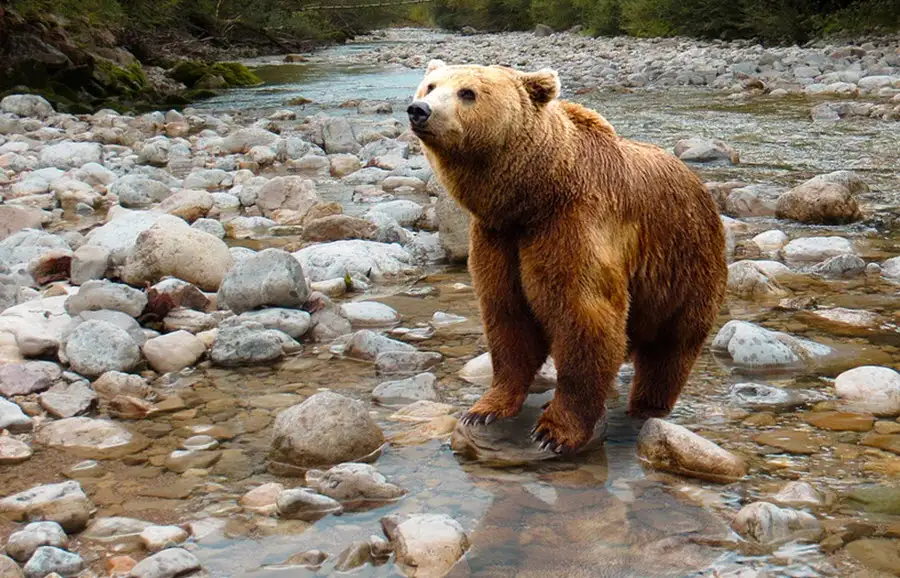Key Takeaways
Only home: a small sector of Mongolia’s Gobi Desert, tightly tied to scarce springs and oases.
Status: Critically endangered (per expert groups and the Mongolian Red List).
Size of population: genetic monitoring suggests ~31 bears, with a male-biased sex ratio and very low genetic diversity.
Top threats: habitat loss/fragmentation, climate-driven aridity, and the risks that come with an extremely narrow gene pool.
Protection in progress: the Gobi Bear Project (GPS tracking, supplemental feeding, genetic sampling) alongside long-standing hunting bans.

Scientific name: Ursus arctos gobiensis
Local name (Mongolian): Mazaalai
Ecological niche: a desert-adapted brown bear, synchronized with permanent/seasonal water points and patchy plant foods in one of Earth’s harshest landscapes.
Unlike most brown bears, Gobi bears persist in hyper-arid, high-temperature environments with sparse vegetation and limited free water—driving a smaller body size and a largely plant-based diet.
The Gobi Desert: spans southern Mongolia and northern China (~1.295 million km²).
Gobi bear core area: roughly 23,600 km², a mosaic of oases, spring lines, alluvial fans, and foothill ravines where water is available.
Isolation: the population is effectively cut off from other brown bear groups by inhospitable desert and human land use, leading to reproductive isolation and genetic erosion.
Bottom line: water is the lifeline. Spring reliability and distances between water points constrain movements, energy budgets, reproduction, and survival.
Body mass: males ~96–138 kg; females ~51–78 kg—smaller than most brown bear populations.
Diet: primarily berries, roots, and other plants; there’s no firm evidence of predation on large mammals.
Behavior: energy-saving routines around water and seasonal food patches, with thermal avoidance during extreme heat.
Why low genetic diversity matters: fewer alleles and a skewed sex ratio shrink the effective population size (Ne), elevating risks of inbreeding depression, disease susceptibility, and reduced adaptive capacity.
Population size: long-term genetic sampling, camera traps, and GPS collars indicate around 31 individuals, broadly stable at a very low level over time.
Sex structure: evidence of male bias, which further lowers reproductive output.
How they’re monitored:
GPS/satellite collars (on ~20 individuals) to map movements, seasonal core areas, and water reliance.
Non-invasive genetics (hair/feces) to track relatedness, sex ratio, and effective population.
Camera traps across feeding sites and oases to fill data gaps.
Habitat loss & fragmentation
Mining, roads, and other developments constrain oasis–spring networks and movement corridors.
Climate change
More frequent drought and extreme heat dry out water points and diminish vegetation quality/quantity.
Genetic bottleneck
Very low diversity cuts resilience to pathogens and environmental shocks.
Potential for conflict
In severe dry years, bears can edge closer to human infrastructure and managed feeding sites, increasing management complexity.
Hunting ban since 1959 and expansion of strictly protected areas in key habitats and corridors.
Movement ecology: GPS collars reveal seasonal routes, core ranges, and water-point dependence.
Population genetics: hair/fecal DNA clarifies kinship, sex ratio, and Ne trends.
Supplemental feeding (since 1985): small, dispersed, seasonal provisioning to help bears through harsh winters while avoiding dependence or crowding.
Human-activity management: speed limits, night-time restrictions, and buffer rules in sensitive zones.
Water-centric corridor protection
Buffer perennial and seasonal springs; keep heavy-impact projects out of movement bottlenecks.
Map “climate refugia”
Use terrain/temperature/groundwater modeling to prioritize micro-habitats that retain moisture during extreme drought.
Optimize supplemental feeding
Stick to multi-site, low-dose, staggered timing to reduce disease/aggregation risks.
Evaluate genetic rescue (only with strict safeguards)
Consider options only if in situ measures cannot stave off inbreeding depression; proceed within rigorous risk, disease, and ethics frameworks.
Community & cross-sector co-management
Shared patrols and rapid-reporting with herders, road operators, and mines; compensation or incentives linked to water-source protection.
Long-term finance & public engagement
Leverage the “world’s rarest brown bear” narrative to fund collars, camera grids, lab analyses, and ranger support, favoring low-impact eco-education over mass tourism.
Q1: How do Gobi bears survive the dry season?
They anchor around oases/springs and rely on berries, roots, and drought-tolerant plants, pairing that with heat-avoidant activity patterns to save water.
Q2: Why is genetic diversity such a big deal?
A narrow gene pool reduces the population’s ability to fight disease and adapt to rapid environmental shifts, while raising the likelihood of inbreeding-related fitness costs.
Q3: How are such rare animals monitored without disturbance?
Through a blend of satellite collars, camera traps, and non-invasive DNA from hair/feces—minimizing handling while maximizing data quality.
animal tags: gobi bear
We created this article in conjunction with AI technology, then made sure it was fact-checked and edited by a Animals Top editor.